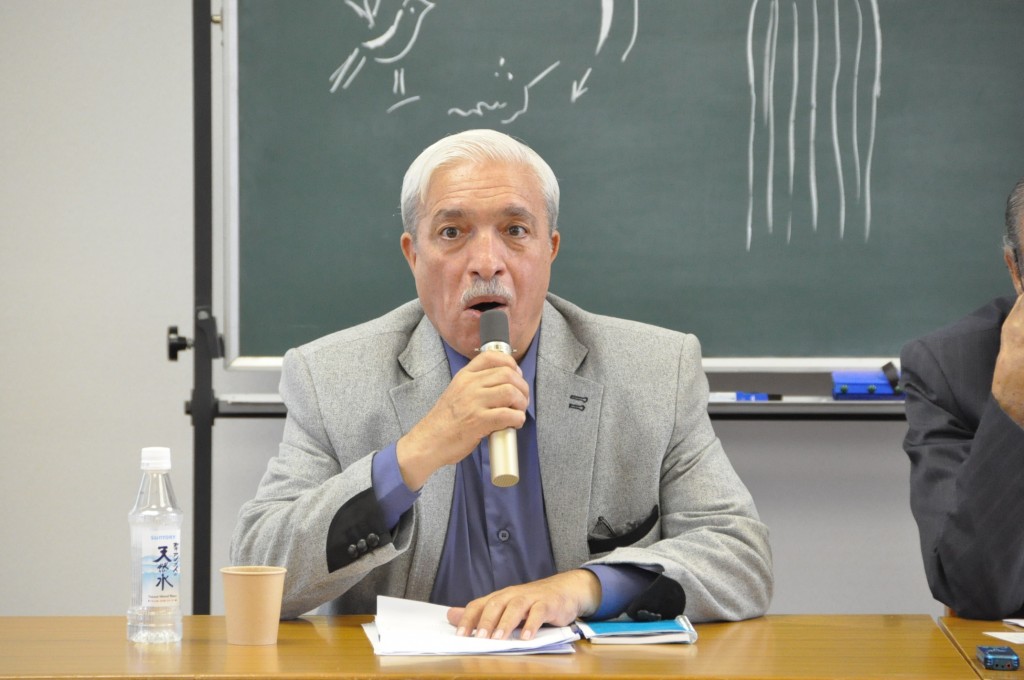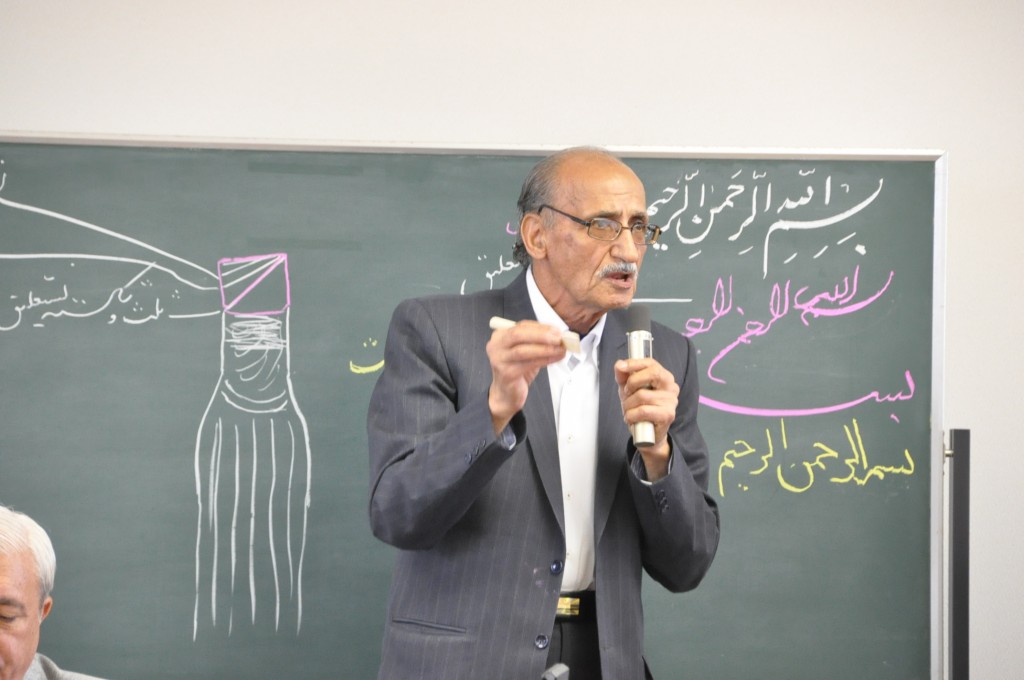Center for Interdisciplinary Study of Monotheistic Religions(CISMOR)Doshisha University
> Public Lectures > Persian Islamic Culture: From a viewpoint of calligraphy and poetryPublic Lectures
Persian Islamic Culture: From a viewpoint of calligraphy and poetry
| Date: |
2013/10/05 13:00~15:30 |
|---|---|
| Place: | Conference Room, Shisei-kan, Imadegawa Campus, Doshisha University |
| Lecture: |
Hasan Ahangaran (Persian calligrapher) Aliasghar Saem (Persian poet) |
| Summary: | |
|
On October 5, 2013, the Center for Interdisciplinary Study of Monotheistic Religions (CISMOR), Doshisha University, held open lectures jointly with the Japanese Office of Al Mustafa International University. On that day, lectures were given by Dr. Hasan Ahangaran, a leading calligrapher from Iran, and Mr. Aliasghar Saem, a celebrated Iranian poet. They both introduced Persian culture, focusing on calligraphy and poetry. First, Dr. Ahangaran explained Persian calligraphy. According to him, there were once 75 hand writing styles in Persian calligraphy, 10 of which have survived to this day. Of those styles, the following four are most commonly used: Nastaleeq, Shekasteh Nastaleeq, Thuluth, and Naskh. Nastaleeq, the most well-known style in Persian calligraphy, is believed to be the most beautiful. It is often referred to as “the bride of the Islamic styles of writing” and is used for writing books. Shekasteh Nastaleeq, the cursive style of the Nastaleeq, was developed as a means for shorthand and penmanship. Nastaleeq and Shekasteh Nastaleeq were invented in Iran 800 years ago and 300 to 400 years ago, respectively. On the other hand, Thuluth and Naskh are widely used across the Islamic world. There are many common elements in the Japanese and Persian arts of calligraphy. Most importantly, both art forms communicate the message of the calligrapher by means of beautiful forms of characters. Of course there are differences between the two in terms of technique. For instance, while a Japanese calligrapher holds a brush perpendicular to the paper, an Iranian artist holds a brush slightly obliquely. In both art forms, characters have thick and thin lines. In Persian calligraphy, an artist uses different parts of a brush end to create thick and thin strokes. The part of the brush closer to the user is called “onsi” (familiar or tamed) and the part farther from the user is called “vahshi” (wild or untamed). The end of a brush is called “zaban” (tongue). Students of Persian calligraphy must learn the art form using the following three steps. The first step is viewing. Viewing their teacher’s work, they must learn about brushstrokes. Next, they imitate the teacher’s brushstrokes as faithfully as possible. Only after practicing the viewing and imitating of the teacher’s brushstrokes, can they proceed to the third and final step. In this step, instead of imitating, students write characters in their own style. This final step is called the practice of creative writing using the imagination. Following the presentation by Dr. Ahangaran, the audience members practiced Persian calligraphy, first tracing the strokes printed on a sheet of paper provided to each audience member. Outstanding features of this calligraphy lesson included the following: (1) The poem printed on the handout was a work by Mr. Saem, one of the lecturers. (2) The audience members were able to hear the poet reciting his own poem. (3) Members learned how to read the poem by following the recitation by the poet first word by word, and then phrase by phrase. (4) The meaning of the beautiful poem was printed in Japanese in the lower part of the handout. (5) On the handout, the poem was printed in a dark color, and then in a light color. The audience members first traced the characters in the light color, and then transcribed the poem. Next, Mr. Saem delivered a presentation on a theme concerning the roles of Persian literature in various stages of mysticism. First, he explained the relationship between secular love and mysticism. According to Mr. Saem, even secular love, which is provisional, can be sacred, if it is unselfish and faithful. Such a love is the first step toward mysticism, since provisional love serves as a bridge, and by crossing the bridge, we can reach the territory of true love. The renowned Persian poet, Rumi, states in one of his poems that a person who is fascinated by someone else and who loves that person deeply will finally begin to love God. Mr. Saem then explained the way that leads people to Allah, illustrating seven stages on the way: the desire to seek Allah; deep love; knowledge and wisdom; independence; tawhid (Oneness of God); amazement; and disappearance of Self. The last stage is the most beautiful, supreme state of the mind, where nothing blocks the view of God, who reveals Himself, and all creatures see nothing but their Creator. This is the state of the mind that the poet describes in his poem. Finally, Mr. Saem introduced a few episodes of the late Mr. Sohrab Sepehri, one of the most celebrated poets in Iran with whom Mr. Saem enjoyed a close friendship. Mr. Saem concluded his presentation with some episodes illustrating how pure and sensitive Sepehri was and how much he respected nature and humanity. In addition to the presentations, the highlights of the meeting were the demonstration of Persian calligraphy and the recitation of poems. Participants also asked many questions during the Q&A session. Participants were provided with the following items: (1) A CD containing calligraphic works by Dr. Ahangaran, including those of Mr. Saem’s poems (2) Tools of Persian calligraphy (a brush, ink, and paper) (3) A piece of beautiful paper on which each participant’s name had been written in Dr. Ahangaran’s brushwork. (4) Certificates of participation in the lectures “Persian Islamic Culture: From the Viewpoint of Calligraphy and Poetry,” signed by Dr. Ahangaran (and Mr. Saem) to those who wished them. (Tomoki Asaka, Research Fellow, CISMOR, Doshisha University) |
|
|
*Lecture in Persian: Interpretation Available *Admission Free, No Reservation Necessary. Hosted by: Al-Mustafa International University in Japan Office, CISMOR Co-hosted by: School of Theology, Doshisha University |
|
|
Program |
|

